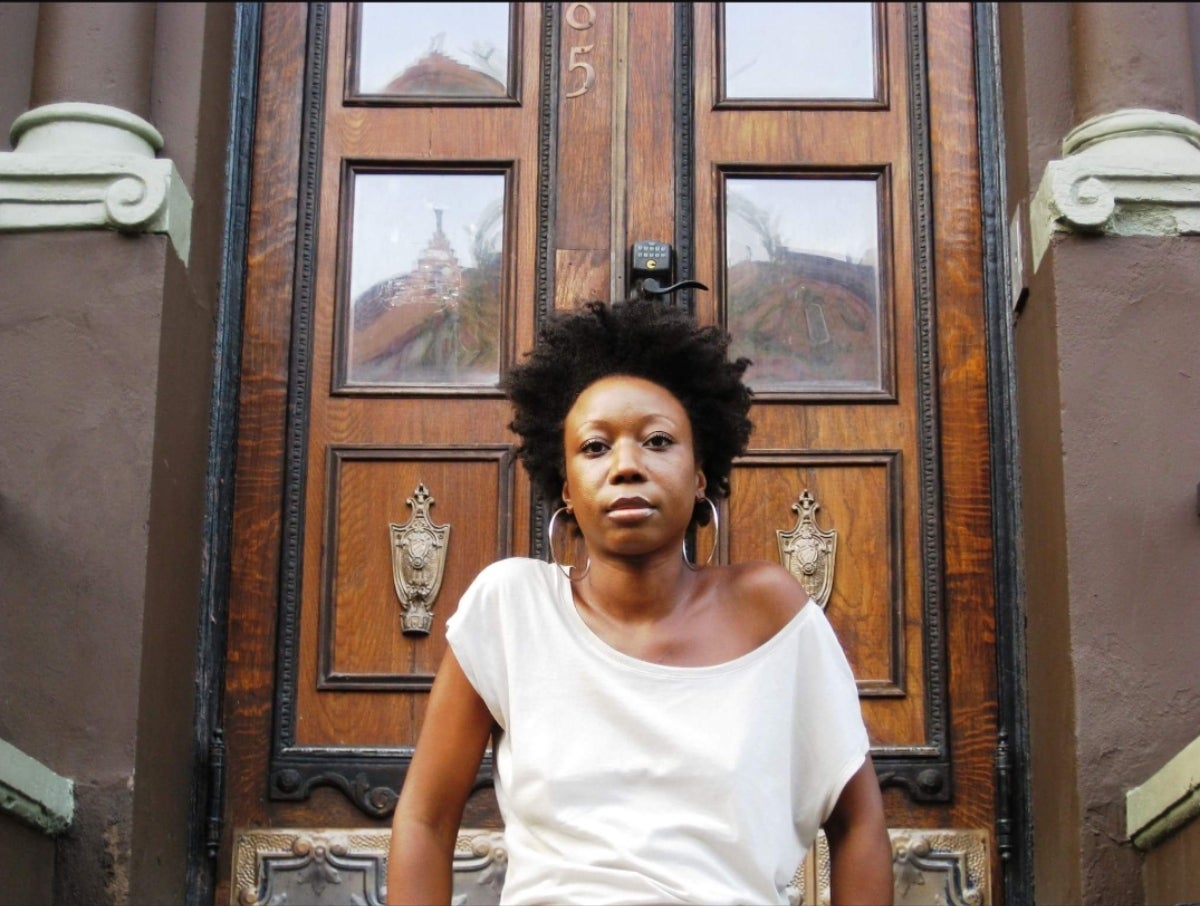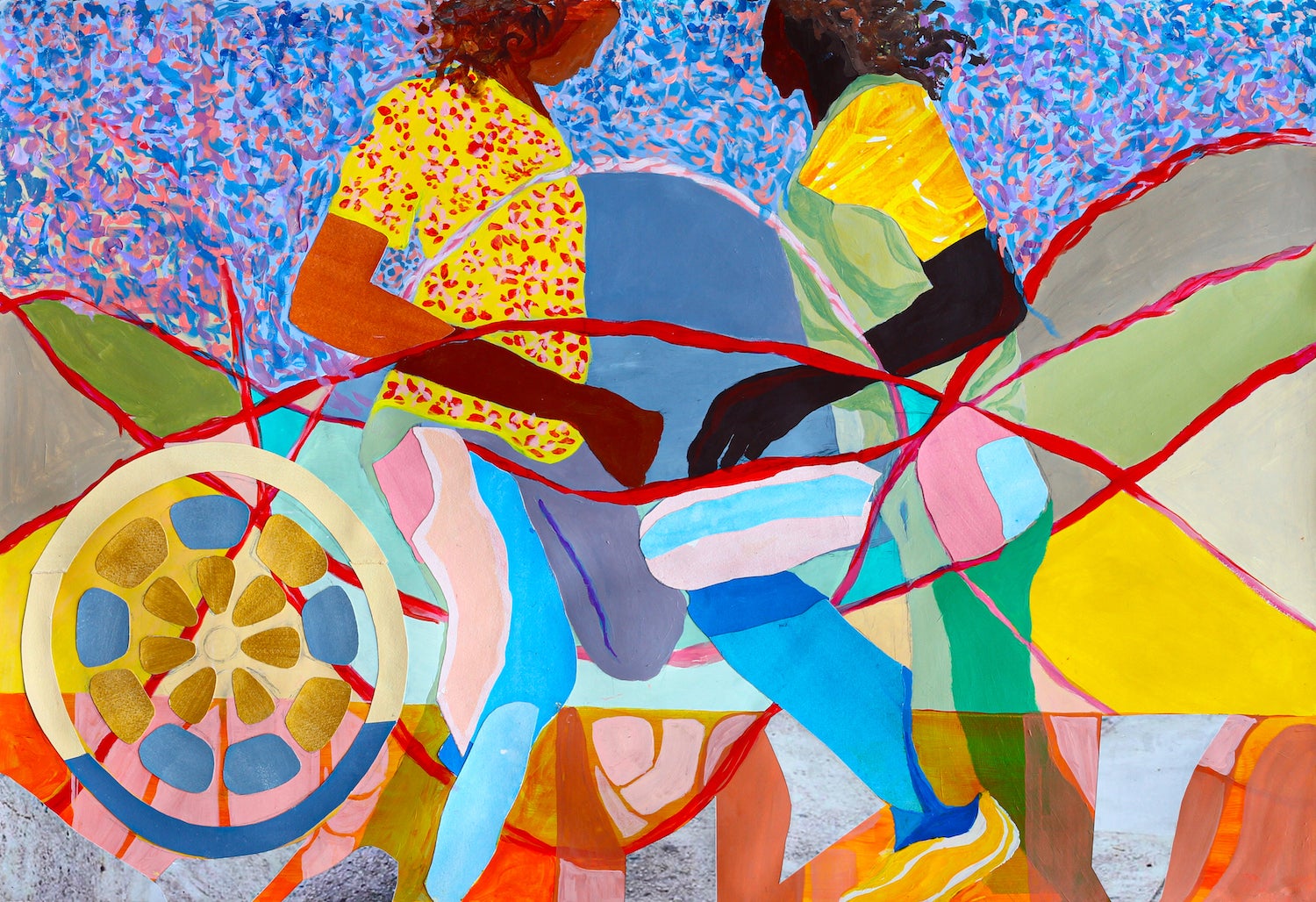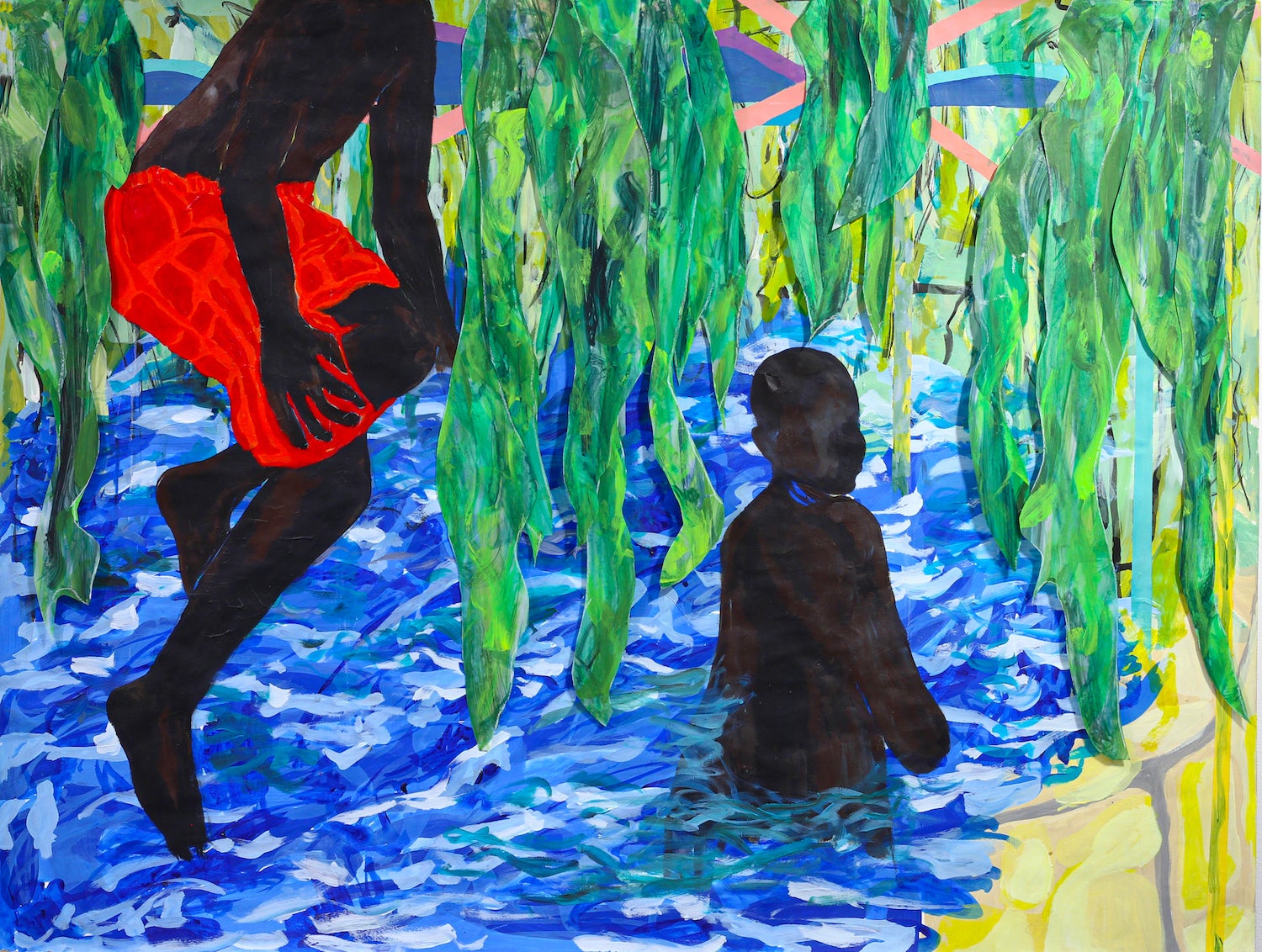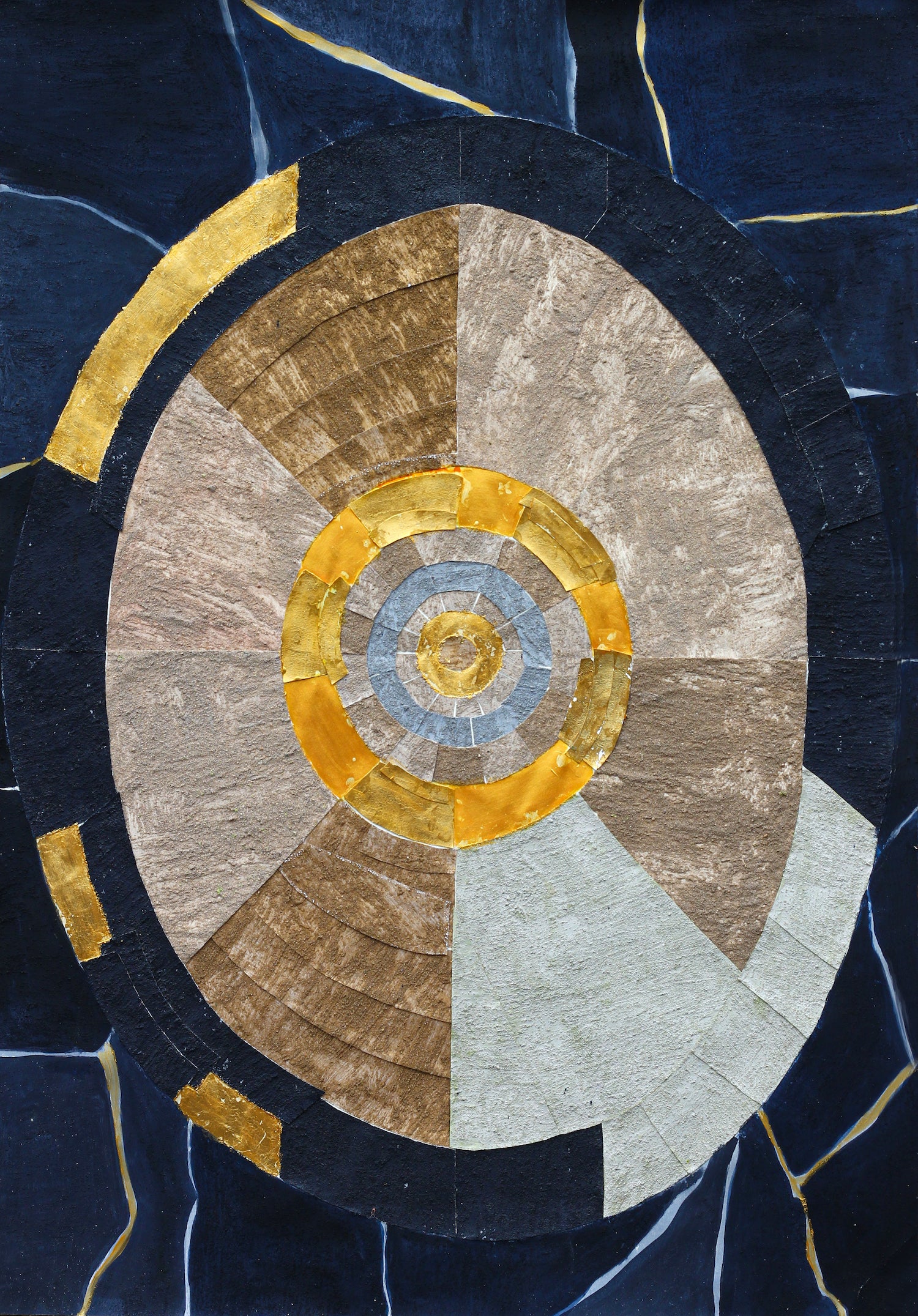
Harlem-born Kimberly Becoat is a Brooklyn resident and mixed media artist whose work explores issues of societal constructs and malaises with an unsparing, critical eye and remarkable empathy. In doing so, she makes us aware of what’s happening within our communities and the forces at work to deny us agency, independence, and self-determination.
In her recent project, Urbania, currently on view at The Museum of Contemporary African Diasporan Arts in Brooklyn, NY, Becoat draws on her own experiences and brings viewers into some of the social aspects of dwelling in public housing projects. She explores the games, colors and ways residents choose to interact, highlighting the frequently forgotten aspects of Black lives in New York City, in the 16 original pieces of her new body of work.
Here we speak with Becoat about her latest project and all-seeing eye.
Aside from the gorgeous visual pleasure of looking at Urbania, what are some of the social, political implications at play that you can share with us?
KIMBERLY BECOAT: What’s happening in Urbania land is a conversation about urban landscapes how they’re developed, why they’re developed, what they were designed to do (or separate a people from doing) for the people that inhabit them and more importantly, how the people within them chose to cultivate their own narrative, codes from two core cultures, and social dynamics within them. It’s also a resurrection of information that is lost to many who are not natives to New York City and never pay attention to these areas – and last, a resurrection and revitalization on the beauty of the projects in other states. It’s a reimagining.

You could have chosen to work in only oil, acrylic, watercolor or so, why mixed media?
BECOAT: Working in mixed mediums allows me to move through the narrative or overall concept behind a body [or series] of work more fluidly than attempting to express it with just painting or collaging or whatever. It’s me making an active choice to go where the work wants to go and then marry it with my signature touches.
To get a sense of real scale, what is the range of your canvases?
BECOAT: My work can go from 10 feet or more to as small as 5 inches. These newer works in the Urbania series fall somewhere in the middle area – around 5 feet to smaller works 24 inches.
Aside from canvases or linen, do you also do works on paper?
BECOAT: All the works in the Urbania series are on paper. I know it looks like canvas that I am constructing on but is indeed a conscious choice to craft this particular series on paper. It gives the work a tapestry vibe that I’ve fallen in love with. Actually, I work more on paper than canvas these days.

Describe for us your artistic developments over the last decade or more.
BECOAT: I’ve been refining a lot of techniques into little systems that allow me to move the ideas more fluidly. For example, I use sand mixed with acrylic in a lot of my work and fabrics with multiple dyes in others – and I’ve developed lovely ways to keep those mixes together on a piece to last as well as get look I want. How I do that is a secret though *laughs*.
What have been the highlights, even your low moments during these artistic developments?
BECOAT: Great question. Low lights are always more important when developing in a new material and turning it into beautiful highlights – so I would say artistically just paying deeper attention to the mistakes – for example when the paper rips on an overlay of multiple materials I’ve mixed together on the work. My thoughts do not immediately run to destroying the entire work. I’m more apt to leave it and come back to it and figure out what these materials are asking me to see in order to put them together cohesively to tell the story I want in the work. I have to say after looking at a lot of work from this series I’ve done a damn good job making those adjustments into a lovely highlight reel of works.
Do you think that you’ve by now reached mastery of your practice or is it an ever-ongoing process?
BECOAT: There’s a saying I love, ” You know what you know – you know what you don’t know – But you don’t know what you don’t know” (laughing). I know that I’ve mastered a great deal. I know what I’ve yet to master (but I’m getting there) – but there’s an outlier of information in an art practice of mediums that I’ve seen, and I say “wow – I didn’t even know I didn’t know that or that was possible” – yes and no… always ongoing.

Where do you draw your inspiration from?
BECOAT: Everywhere. Seriously- I know that’s a generic answer- but the truth of the matter is I could be watching a TV show or hear some tidbit of a conversation traveling and it will spark me down a rabbit hole. I love playing investigator – I love researching deeper after I learn/hear stuff. Intertwine it with my lifelong insistence to always speak from a Black American framework well there you go! There’s so much there to work from – because so much of the Black [and Brown] American experience – just in enjoy living separate from fighting and rallying for our rights has not been explored or told.
What are your favorite art periods and why?
BECOAT: Tough question! – My favorites right now would be the Black Arts Movement of the 70s and the 80s early 90s – that was such a broad range of work from everyone on both coasts. You still had master Black artists working and producing and creating spaces to show. The Black women artists that came from those decades! Whew.
Who are some of your favorite artists and why?
BECOAT: Howardena Pindell/Betye Saar/Mark Bradford/Jack Whitten on range of use materials alone the kings and queens of assemblage – I learn something new to try every time I look at their work. And then Emma Amos, Alice Neel, Cy Twombly, Kerry James Marshall, Stanley Whitley – as a painter for me – their mastery of color is chef’s kiss – I referred to them a lot doing my Urbania works creating my own color codes from hood/bodega store staples. And Alma Thomas – she was an art educator and artist – that is not easy to do because you pour so much into the youth to be able to do the work she created at a high level of production and aesthetic is incredible – as an artist that also teaches youth, she inspires me daily that it is possible.

Returning to Urbania, for those not previously familiar with your work, is this a continuation or departure from your previous works.
BECOAT: I work on several bodies of work simultaneously- so when I was working or beginning the concept for Urbania way back 10 years ago with earlier pieces I was also working on pieces about the modern day hottentots and laying out the work for Seneca Village which actually was the catalyst (both series) for Urbania – a person might think I’ve departed from a particular style but no, collage, painting, mixing other materials are all in works whether I decide to make it abstract or gesture to a figure – in my head it’s all the a continuation.
What is Urbania about?
BECOAT: Urbania has several parts to it – this mid part that this solo exhibition speaks to is opening up a passageway into an area (or areas) of New York City where NYCHA housing is constructed and also more out of NYC- the areas in other states affectionately called the Projects. I’m speaking to those social dynamics/rituals and cultures of those that have grown up in those dwellings – as they have seemingly been abandoned either in a physical way or economics throughout the years. This mid part is lighter in tone and subject matter as I’m incorporating hood games like Skelly, double Dutch or hood colors I call them from candies we ate like Lemonheads, Now and Laters, or Laffy Taffy. And then addressing areas where we were seemingly invited but felt restrictive in some ways to be there – so I touch upon reclaiming sanctuary and making peace with those spaces outside the hood – like Central Park where the pool resided. This portion and Blackness or Brown skin thriving a placing is center stage in that joy.
What are the major takeaways that you hope that viewers would get from this new body of work?
BECOAT: Overall be active in knowing the people where you reside – one of the biggest resentments against expats in any environment is this unnatural desire to “takeover.” There’s freedom in community – in understanding what was there before you and with you – be a part of the experience not segregated from it. That there’s sanctuary in having a place that even in your mind you can call back to and move forward in no matter you are – never forget your cultural codes – bask in the colors as those are everyday aesthetics that keep you grounded even outside the hood – we are always asked to put them aside – but don’t. That Black people frolic, double Dutch, swim and roller-skate – and that’s all a revolutionary act too. So make sure one does them as often as possible. And that the work invigorates and opens up dialog about all these things for you.
Kimberly Becoat’s current solo exhibition, URBANIA is currently on display at the Museum of Contemporary African Diasporan Arts (MoCADA) at 80 Hanson Place, Brooklyn, New York through June 19, 2022